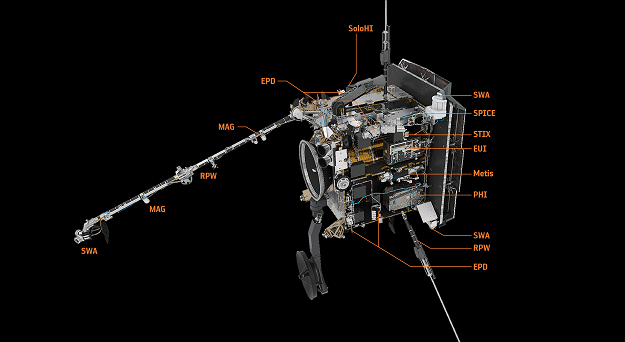Instruments
The scientific payload elements of Solar Orbiter are being provided by ESA Member States, NASA and ESA. They have been selected and funded through a competitive selection process. The Solar Orbiter payload accommodates a set of in situ and a set of remote-sensing instruments, with a total payload mass of 209 kg.
 |
| Payload accommodation onboard Solar Orbiter. Credit: ESA/ATG medialab |
|
The in-situ instruments: |
| EPD: Energetic Particle Detector Principal Investigator: Javier Rodríguez-Pacheco, University of Alcalá, Spain Collaborating countries (hardware): Spain, Germany, USA, ESA EPD will measure the composition, timing and distribution functions of suprathermal and energetic particles. Scientific topics to be addressed include the sources, acceleration mechanisms, and transport processes of these particles. |
| MAG: Magnetometer Principal Investigator: Timothy Horbury, Imperial College London, United Kingdom Collaborating countries (hardware): United Kingdom The magnetometer will provide in situ measurements of the heliospheric magnetic field with high precision. This will facilitate detailed studies into the way the Sun’s magnetic field links into space and evolves over the solar cycle; how particles are accelerated and propagate around the Solar System, including to the Earth; how the corona and solar wind are heated and accelerated. |
| RPW: Radio and Plasma Waves Principal Investigator: Milan Maksimovic, LESIA, Observatoire de Paris, Meudon, France Collaborating Countries (hardware): France, Sweden, Czech Republic, Austria The RPW experiment is unique amongst the Solar Orbiter instruments in that it makes both in situ and remote-sensing measurements. RPW will measure magnetic and electric fields at high time resolution using a number of sensors/antennas, to determine the characteristics of electromagnetic and electrostatic waves in the solar wind. |
| SWA: Solar Wind Analyser Principal Investigator: Christopher J. Owen, Mullard Space Science Laboratory, United Kingdom Collaborating countries (hardware): United Kingdom, Italy, France, USA The Solar Wind Analyser, SWA, consists of a suite of sensors that will measure the ion and electron bulk properties (including, density, velocity, and temperature) of the solar wind, thereby characterising the solar wind between 0.28 and 1.4 AU from the Sun. In addition to determining the bulk properties of the wind, SWA will provide measurements of solar wind ion composition for key elements (e.g. the C, N, O group and Fe, Si or Mg). |
|
The remote-sensing instruments: |
| EUI: Extreme Ultraviolet Imager Principal Investigator: David Berghmans, Royal Observatory of Belgium, Brussels, Belgium Collaborating countries (hardware): Belgium, United Kingdom, France, Germany, Switzerland EUI will provide image sequences of the solar atmospheric layers above the photosphere, thereby providing an indispensable link between the solar surface and outer corona that ultimately shapes the characteristics of the interplanetary medium. EUI will also provide the first-ever UV images of the Sun from an out-of-ecliptic viewpoint (up to 34° of solar latitude during the extended mission phase). |
| Metis: Coronagraph Principal Investigator: Marco Romoli, INAF – University of Florence, Italy Collaborating countries (hardware): Italy, Germany, Czech Republic Metis will simultaneously image the visible and ultraviolet emission of the solar corona and diagnose, with unprecedented temporal coverage and spatial resolution, the structure and dynamics of the full corona in the range from 1.4 to 3.0 (from 1.7 to 4.1) solar radii from Sun centre, at minimum (maximum) perihelion during the nominal mission. This is a region that is crucial in linking the solar atmospheric phenomena to their evolution in the inner heliosphere. |
| PHI: Polarimetric and Helioseismic Imager Principal Investigator: Sami Solanki, Max-Planck-Institut für Sonnensystemforschung, Göttingen, Germany Collaborating countries (hardware): Germany, Spain, France The Polarimetric and Helioseismic Imager, PHI, will provide high-resolution and full-disc measurements of the photospheric vector magnetic field and line-of-sight (LOS) velocity as well as the continuum intensity in the visible wavelength range. The LOS velocity maps will have the accuracy and stability to allow detailed helioseismic investigations of the solar interior, in particular of the solar convection zone. |
| SoloHI: Heliospheric Imager Principal Investigator: Russell A. Howard, US Naval Research Laboratory, Washington, D.C., USA Collaborating countries (hardware): USA This instrument will image both the quasi-steady flow and transient disturbances in the solar wind over a wide field of view by observing visible sunlight scattered by solar wind electrons. It will provide unique measurements to pinpoint coronal mass ejections (CMEs). |
| SPICE: Spectral Imaging of the Coronal Environment Principal Investigator for Operations Phase: Frédéric Auchère, Institut d'Astrophysique Spatiale, Orsay, France Collaborating countries (hardware): United Kingdom, Germany, France, Switzerland, USA This instrument will perform extreme ultraviolet imaging spectroscopy to remotely characterize plasma properties of the Sun's on-disc corona. This will enable matching in-situ composition signatures of solar wind streams to their source regions on the Sun's surface. |
| STIX: X-ray Spectrometer/Telescope Principal Investigator: Samuel Krucker, FHNW, Windisch, Switzerland Collaborating countries (hardware): Switzerland, Poland, Germany, Czech Republic, France STIX provides imaging spectroscopy of solar thermal and non-thermal X-ray emission. STIX will provide quantitative information on the timing, location, intensity, and spectra of accelerated electrons as well as of high temperature thermal plasmas, mostly associated with flares and/or microflares. |
Last Update: 2 July 2020


